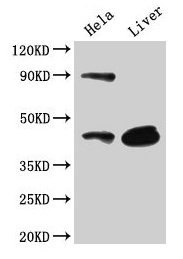![CD46(122.2), CF405S conjugate, 0.1mg/mL [26628-22-8] CD46(122.2), CF405S conjugate, 0.1mg/mL [26628-22-8]](https://biotium.com/wp-content/uploads/2016/12/BNUB0175-0-1.jpg)
CD46(122.2), CF405S conjugate, 0.1mg/mL [26628-22-8]
BNC040175
ApplicationsFlow Cytometry
Product group Antibodies
TargetCD46
Overview
- SupplierBiotium
- Product NameCD46(122.2), CF405S conjugate, 0.1mg/mL
- Delivery Days Customer9
- ApplicationsFlow Cytometry
- CertificationResearch Use Only
- ClonalityMonoclonal
- Clone ID122.2
- Concentration0.1 mg/ml
- ConjugateOther Conjugate
- Gene ID4179
- Target nameCD46
- Target descriptionCD46 molecule
- Target synonymsAHUS2; antigen identified by monoclonal antibody TRA-2-10; CD46 antigen, complement regulatory protein; CD46 molecule, complement regulatory protein; complement membrane cofactor protein; MCP; measles virus receptor; membrane cofactor protein; membrane cofactor protein (CD46, trophoblast-lymphocyte cross-reactive antigen); MIC10; TLX; TRA2.10; trophoblast leucocyte common antigen; trophoblast leukocyte common antigen; trophoblast-lymphocyte cross-reactive antigen
- HostMouse
- IsotypeIgG1
- Protein IDP15529
- Protein NameMembrane cofactor protein
- Scientific DescriptionCD46 acts as a cofactor for complement factor I, a serine protease, which protects autologous cells against complement-mediated injury by cleaving C3b and C4b deposited on host tissue. It may be involved in the fusion of the spermatozoa with the oocyte during fertilization. CD46 acts as a co-stimulatory factor for T-cells, which induces the differentiation of CD4 into T-regulatory 1 cells. T-regulatory 1 cells suppress immune responses by secreting interleukin-10, and therefore are thought to prevent autoimmunity. A number of viral and bacterial pathogens seem to exploit this property and directly induce an immunosuppressive phenotype in T-cells by binding to CD46.Primary antibodies are available purified, or with a selection of fluorescent CF® Dyes and other labels. CF® Dyes offer exceptional brightness and photostability. Note: Conjugates of blue fluorescent dyes like CF®405S and CF®405M are not recommended for detecting low abundance targets, because blue dyes have lower fluorescence and can give higher non-specific background than other dye colors.
- SourceAnimal
- Storage Instruction2°C to 8°C
- UNSPSC12352203





